Venerated as incarnations of Hindu deities, India’s sacred cows are also being touted as agents of energy transition by a government determined to promote biogas production to cut its dependence on coal.
It is an understatement to say that Nakul Kumar Sardana is proud of his new plant in Barsana, in India’s northern Uttar Pradesh state.
Primarily because it occupies “one of the holiest sites in the world,” said the vice-president of a biomass joint venture between India’s Adani Group and France’s TotalEnergies SE.
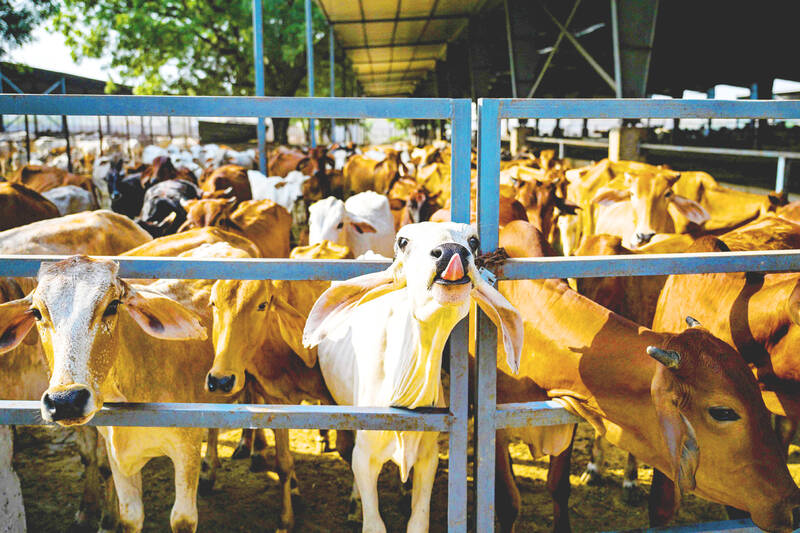
Photo: AFP
A four-hour drive south of the smog-filled capital, New Delhi, among fields bristling with brickyard smokestacks, the small town of Barsana welcomes pilgrims who come to honor the Hindu goddess Radha.
Sardana is also proud because his methanization plant that opened in March is the “most technologically advanced and the largest biogas facility” in India.
It was built in Barsana to be as close as possible to its raw fuel — cattle dung and harvest stubble.
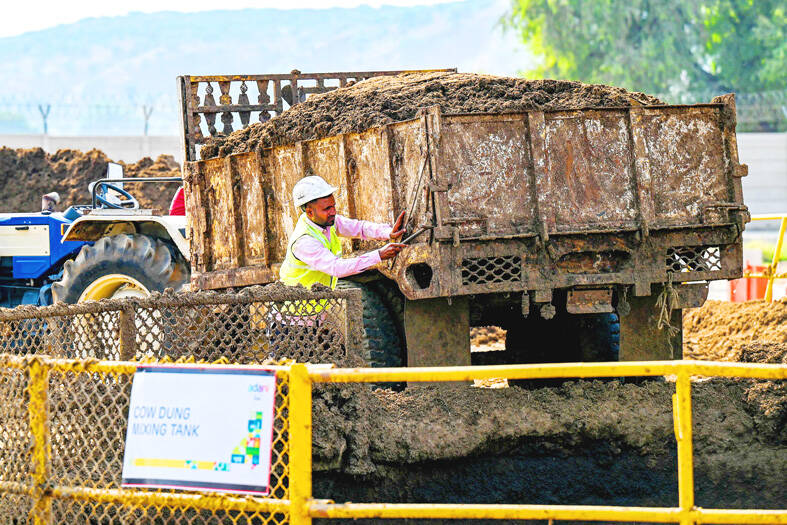
Photo: AFP
“This region is home to a million cows,” Sardana said. “Their dung has been used as fuel for centuries in cooking.”
Cows have been blamed for contributing to global warming because they produce methane — a powerful greenhouse gas — in their manure or when they belch.
In this case, the region is finding a creative use for the waste produced by the cattle, which are used for their milk. Eating them is taboo for many Hindus.
Stalks left behind after the rice harvest — which would otherwise be burned — join the slurry.
“Farmers are traditionally burning them, creating smog and pollution,” Sardana said. “In using natural waste, we are not only producing compressed biogas, but also high-quality organic fertilizer.”
Long lines of tractors dump dung and straw in the factory’s tanks, from which 10 tonnes of gas and 92 tonnes of fertilizer are produced each day.
In its endless quest for power to fuel its economic growth, the world’s most populous nation — and third-largest fossil fuel polluter — has pushed biogas to achieve a much-promised transition to carbon neutrality by 2070.
In 2018, the government set itself an ambitious goal of building 5,000 biogas plants in six years.
Despite generous subsidies and the introduction of a buyback guarantee, the project attracted little initial interest — until the government forced the hand of producers. From April next year, at least 1 percent of liquid gas fueling vehicles and used for domestic use must be biogas — rising to 5 percent by 2028.
That prompted a response from key players, starting with billionaires Mukesh Ambani and Gautam Adani — both close to Indian Prime Minister Narendra Modi — eyeing lucrative public contracts.
Ambani promised his Reliance Industries Ltd would build 55 biogas plants by the end of 2025 to convert “food producers to energy producers” and generate 30,000 jobs.
His rival Adani plans to invest about US$200 million in the sector in the next three to five years.
“The government is pushing to convert waste for the wealth of the country,” said Suresh Manglani, CEO of Adani Total Gas Ltd.
The International Energy Agency said that China and India are leading global growth in bioenergy, seen as one solution to mitigate global heating.
Even though biofuel remains more expensive than conventional gas, Indian production is expected to grow by 88 percent by 2030, it the agency said.
Biogas is considered a clean energy because the waste used to produce it is completely natural, said Suneel Pandey, director of circular economy and waste management at The Energy and Resources Institute, a New Delhi-based research institute.
It is “a sustainable solution to make wealth from waste,” he said.
However, the contribution of biogas to India’s transition away from heavily polluting coal — currently fueling nearly 70 percent of electricity — would be relatively small.
India plans to more than double the share of gas in its energy mix — from 6 to 15 percent by 2030, but the bulk of that would be liquefied natural gas (LNG), with Adani and TotalEnergies opening an LNG port on India’s eastern coast at Dhamra.
Burning gas to produce electricity also releases damaging emissions, although less than coal and oil.
Total said its backing of biogas is more about environmental responsibility than commercial opportunity.
“Biogas goes way beyond figures and business plans,” TotalEnergies chairman and managing director for India Sangkaran Ratnam said.
“It has also a tremendously positive knock-on effect on the rural communities in terms of jobs, in terms of care for the environment, and alternative forms of income,” he said.
Tejpreet Chopra, head of renewable energy company Bharat Light and Power Pvt Ltd, said the biogas market is “small in the big picture of things” but the “potential is huge.”
However, the investments required are vast. The Barsana plant cost US$25 million, while the price of biogas remains uncompetitive: US$14 per cubic meter, compared with US$6 for LNG.
Yet Sardana said he is more convinced than ever that biogas is key.
“We will learn the nuts and bolts of it and improve all processes,” he said. “We stop wasting energy, we create rural jobs, and we are contributing to a more sustainable environment.”
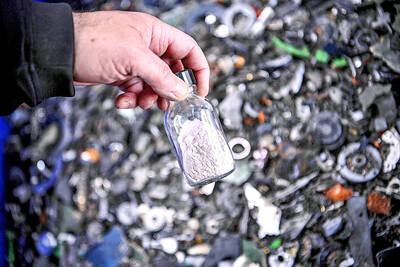
RECYCLE: Taiwan would aid manufacturers in refining rare earths from discarded appliances, which would fit the nation’s circular economy goals, minister Kung said Taiwan would work with the US and Japan on a proposed cooperation initiative in response to Beijing’s newly announced rare earth export curbs, Minister of Economic Affairs Kung Ming-hsin (龔明鑫) said yesterday. China last week announced new restrictions requiring companies to obtain export licenses if their products contain more than 0.1 percent of Chinese-origin rare earths by value. US Secretary of the Treasury Scott Bessent on Wednesday responded by saying that Beijing was “unreliable” in its rare earths exports, adding that the US would “neither be commanded, nor controlled” by China, several media outlets reported. Japanese Minister of Finance Katsunobu Kato yesterday also
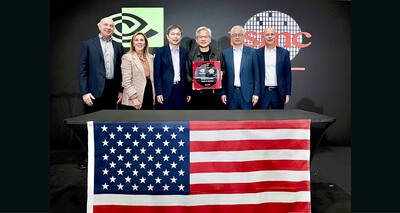
Jensen Huang (黃仁勳), founder and CEO of US-based artificial intelligence chip designer Nvidia Corp and Taiwan Semiconductor Manufacturing Co (TSMC, 台積電) on Friday celebrated the first Nvidia Blackwell wafer produced on US soil. Huang visited TSMC’s advanced wafer fab in the US state of Arizona and joined the Taiwanese chipmaker’s executives to witness the efforts to “build the infrastructure that powers the world’s AI factories, right here in America,” Nvidia said in a statement. At the event, Huang joined Y.L. Wang (王英郎), vice president of operations at TSMC, in signing their names on the Blackwell wafer to
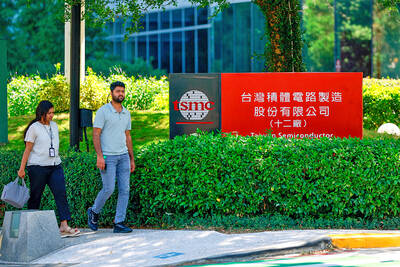
‘DRAMATIC AND POSITIVE’: AI growth would be better than it previously forecast and would stay robust even if the Chinese market became inaccessible for customers, it said Taiwan Semiconductor Manufacturing Co (TSMC, 台積電) yesterday raised its full-year revenue growth outlook after posting record profit for last quarter, despite growing market concern about an artificial intelligence (AI) bubble. The company said it expects revenue to expand about 35 percent year-on-year, driven mainly by faster-than-expected demand for leading-edge chips for AI applications. The world’s biggest contract chipmaker in July projected that revenue this year would expand about 30 percent in US dollar terms. The company also slightly hiked its capital expenditure for this year to US$40 billion to US$42 billion, compared with US$38 billion to US$42 billion it set previously. “AI demand actually

Taiwan-based GlobalWafers Co., the world’s third largest silicon wafer supplier, on Wednesday opened a 12-inch silicon wafer plant in Novara, northern Italy - the country’s most advanced silicon wafer facility to date. The new plant, coded “Fab300,” was launched by GlobalWafers’ Italian subsidiary MEMC Electronics Materials S.p.A at a ceremony attended by Taiwan’s representative to Italy Vincent Tsai (蔡允中), MEMC President Marco Sciamanna and Novara Mayor Alessandro Canelli. GlobalWafers Chairwoman Doris Hsu (徐秀蘭) said the investment marked a milestone in the company’s expansion in Europe, adding that the Novara plant will be powered entirely by renewable energy - a reflection of its